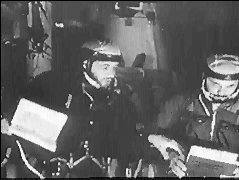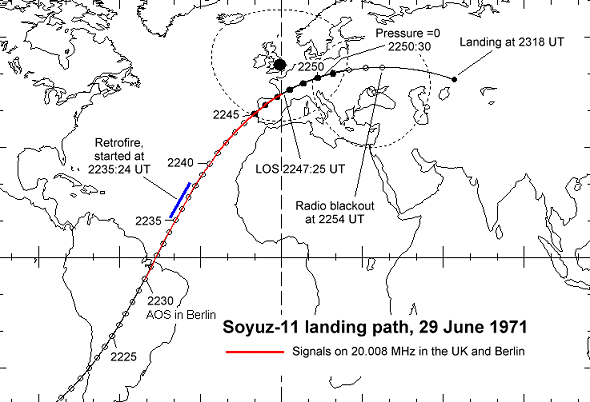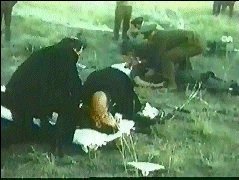 The
Soyuz-11 disaster
The
Soyuz-11 disaster The
Soyuz-11 disaster
The
Soyuz-11 disasterIn June 1971 the second expedition to Salyut-1 ended tragically when the crew died because of decompression of their capsule during descent. However, the flight had not been without other problems. Before launch the prime crew (Leonov, Kubasov, Kolodin) had been replaced just four days before launch with the back-up crew Dobrovolskiy, Volkov, and Patsayev (see picture on the right. Credit: Mark Wade's Encyclopedia Astronautica). The reason was that Kubasov was suspected of having contracted tuberculosis. While in flight there was a fire in a cable bundle on Salyut-1 on June 16 and a serious personality clash between the commander Dobrovolskiy - a rookie cosmonaut - and veteran cosmonaut Volkov (3).
The mission was planned to last 25 days and the crew initiated their return to Earth on 29 June 1971. The recovery phase was, to a certain extent, observed by the Kettering Group. Here is what Geoff Perry, then Senior Science Master at Kettering Grammar School wrote at the time (4):
 "I
picked up my first signals for over 7 days on 28 June around 2110
UT
- Salyut on 20.008 MHz and assumed that recovery would take place on 29
June around 2000 UT. Consequently I set the alarm clock for 3.a.m. BST
hoping to see two objects indicating that Soyuz-11 had separated from
Salyut
but that was not to be. We had no signals during 29 June and when 2000
UT came and went I went off watch, but, fortunately, left the time
switch
to do the pass at 2230 and 0300 UT. I did not believe that the Russians
would worry about a recovery in darkness at this time of the year,
considering
their usual precision landings.
"I
picked up my first signals for over 7 days on 28 June around 2110
UT
- Salyut on 20.008 MHz and assumed that recovery would take place on 29
June around 2000 UT. Consequently I set the alarm clock for 3.a.m. BST
hoping to see two objects indicating that Soyuz-11 had separated from
Salyut
but that was not to be. We had no signals during 29 June and when 2000
UT came and went I went off watch, but, fortunately, left the time
switch
to do the pass at 2230 and 0300 UT. I did not believe that the Russians
would worry about a recovery in darkness at this time of the year,
considering
their usual precision landings.
However, they did worry and Soyuz-11 went two extra revs to give a daylight recovery. The time switch recorded signals 45 s after it had operated with LOS at 2247:15 +/- 15 s (allowing for possible variations in mains frequency affecting the clockwork). Peter Bentley had banked on a daylight recovery and was listening at Menai Bridge and gives LOS at 2247:27 +/- 1 s (or, as he says, +/- 5 s for 99% accuracy). I have therefore adopted 2247:25 +/- 5 s as LOS and the time of separation of the descent module and instrument module. The tragedy must have occurred minutes, or even only seconds, later. Telemetry at LOS was normal for a Soyuz recovery".
Interestingly, the Soviet official time of separation (revealed many years later) is 2247:28 UT (3). The map shows the receptions by the Kettering Group during this fateful evening and other related flight events (5). The Soviet account of the disaster is given in an official source (1):
"At approximately 723 seconds after retrofire, the 12 Soyuz pyro cartridges fired simultaneously instead of sequentially to separate the two modules .... the force of the discharge caused the internal mechanism of the pressure equalization valve to release a seal that was usually discarded pyrotechnically much later to adjust the cabin pressure automatically. When the valve opened at a height of 168 kilometers the gradual but steady loss of pressure was fatal to the crew within about 30 seconds. By 935 seconds after retrofire, the cabin pressure had dropped to zero....... ...only trough analysis of telemetry records of the attitude control system thruster firings that ahd been made to counteract the force of the escaping gases and through the pyrotechnic powder traces found in the throat of the pressure equalization valve were Soviet specialists able to determine that the valve had malfunctioned and had been the sole cause of the deaths."
Aviation Week also reported in 1974 that the crew had tried to close a backup valve but had not been able to turn the hand crank valve fast enough. In James Oberg's book (2) he relays a rumor that an indication of the leak had been received on the Soyuz instrument panel upon casting off from the Salyut, but that instead of redocking and analyzing the possible problem the crew had been ordered by General Kamanin to proceed with the landing and ignore the leak indication. This turns out to be a somewhat distorted version of actual events where the indicator light showing that the hatch between the descent and orbital modules was open refused to go off. It seems that the indicator switch was slightly out of position and by placing an object in front of it the indicator light went off (3). The Soyuz finally undocked from Salyut-1 at 1825:15 UT while over the Yeniseysk ground station in Siberia.
In (3) we learn that the crew noticed a leak immediately, probably from the hissing noise it generated, rushed to the front hatch thinking that this earlier problem was related to the sound. To locate the source of the noise the crew turned off all radios. They probably located the leaking valve under one of the seats and tried to close it manually. All this must have happened very quickly, possibly in less than 20 seconds because that is how long the crew would have remained capable of work after the start of the leak. Two minutes after the start of the leak the pressure had dropped to zero and the crew were dead. In (3) we also learn that the valve in question was not a pressure equalization valve but a fresh air valve to be opened after landing,
The detailed information in (3) and (1) could not have been obtained through telemetry, because after separation from the service module there is no telemetry transmission from the descent module. Telemetry is recorded onboard. In the case of Soyuz-11 there was a recording device called "Mir" (3). We know that in the Soyuz TM descent vehicle there is a data recorder called "Mir-3A-1" capable of recording up to 64 analog channels at a sampling rate of 31.25 Hz and 128 on-off channels. The recording time is 76 minutes.
After service module separation the Soyuz VHF voice system normally starts transmitting "AN" morse code signals on the standard 121.75 MHz FM voice link. On the present Soyuz TM design the antenna for this link is a slot antenna located in the lid of the crew ingress/egress hatch at the top of the capsule. Whenever a cosmonaut wishes to talk to the ground he presses his microphone button and the Morse code signal is interrupted. Uplink to the re-entry vehicle is on 130.167 MHz as usual. When the parachute has been deployed the system switches to 121.5 MHz AM for the down link and 130.167 MHz AM for the uplink. This switch of modulation type is consistent with operation with standard international search-and-rescue radios that operate on AM. Indeed the frequencies used are in the aircraft band where AM is used. The "AN" message repeats three times in ten seconds and followed by a 15 second pause. (Listen to simulated AN signal). After parachute deployment AN beacon signals are also transmitted as CW keyed signals on 8.364 MHz and 18.060 MHz.
 Ground
control probably wondered why nothing was heard from the Soyuz-11 crew
during descent. At separation from the orbital and service modules the
descent vehicle was out of range from Soviet ground stations. However,
two minutes later, by the time the pressure had dropped to zero the
descent
vehicle was over the horizon at Yevpatoria and there would be another 3
minutes until radio blackout. Nothing was heard from the crew during
this
period of course but, despite this, the rescue crews were probably
completely
unprepared by what they saw when they opened the capsule after landing.
The descent vehicle landed at 2318 UT at a spot 202 km east of
Dzhezkazgan
in Kazakhstan and after finding the crew lifeless in the capsule
attempts
by rescue crews to revive the crew were all in vain (see picture on the
right. Credit: Mark Wade's Encyclopedia Astronautica). Thus ended a
very
tragic episode in the Soviet space programme.
Ground
control probably wondered why nothing was heard from the Soyuz-11 crew
during descent. At separation from the orbital and service modules the
descent vehicle was out of range from Soviet ground stations. However,
two minutes later, by the time the pressure had dropped to zero the
descent
vehicle was over the horizon at Yevpatoria and there would be another 3
minutes until radio blackout. Nothing was heard from the crew during
this
period of course but, despite this, the rescue crews were probably
completely
unprepared by what they saw when they opened the capsule after landing.
The descent vehicle landed at 2318 UT at a spot 202 km east of
Dzhezkazgan
in Kazakhstan and after finding the crew lifeless in the capsule
attempts
by rescue crews to revive the crew were all in vain (see picture on the
right. Credit: Mark Wade's Encyclopedia Astronautica). Thus ended a
very
tragic episode in the Soviet space programme.